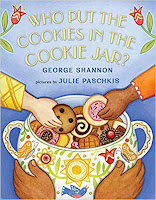After reflecting on my favorite reads of the past year, I decided to turn my attention to the programs I led over the last year. This proved much harder to narrow down! Luckily, most of my programs have gone really well, with storytimes being the most variable it seems, mainly because attendance at the weekend family storytime I do varies so much from week to week, in terms of numbers and ages, and really doesn't have a regular crowd.
As a part-timer, I don't do as many programs as others, but I'm pretty happy with the variety that I've gotten to do. My regular programs include the weekend family storytime once each month, a monthly outreach visit, and a monthly after-school program for elementary ages, which is usually a STEM program, though occasionally a colleague and I will switch so she gets a chance to do STEM, and I get a chance to do arts/crafts. I also did a variety of other programs during the summer and occasionally do something special or sub for another storytime.
Favorite Storytimes
My recent Cookie storytime was a lot of fun, and though the attendance was extremely low, the audience and I really enjoyed the books. My special Happy Birthday, Very Hungry Caterpillar storytime was also a lot of fun, and the caterpillar & butterfly craft I did with that is probably the best storytime craft I've done so far. Then, of course you can't go wrong with a Dinosaur storytime, which was probably the best attended and finally had kids come sit right up front. None of these are particularly original or creative themes, but they worked well.
Favorite STEM Program
I don't think I can pick a true favorite here! My favorite at any given time is usually the most recent one that has gone well, and fortunately most of them have gone well. But, if I had to name one, I guess it would be the "Pumpkin Science" program because it involved a variety of activities from different disciplines, everything worked the way I wanted, the set-up didn't take long, there was surprisingly little clean-up, and everyone seemed to have a great time.
A couple of others that stand out in my memory are "Ice Fishing & Other Icy Experiments" because of its elegant simplicity, low cost, and fun; and "Germs" because it gave me a chance to put my previous career as a microbiologist to use.
Favorite Special Program
In this case "special" means that it's not something I do on a regular basis like family storytime and monthly elementary STEM programming. This is a tie between my recent pair of family mini-Gingerbread House programs, and the preschool "Dinosaur Dig" program I did this summer. I would also say that these two are my top favorite programs of the year overall.
I used to be a semi-professional confectionery artist, and made these mini-gingerbread houses with my daughter. I've always wanted to do it as a library program, and finally got the chance this year. I was a little nervous about doing it with such a large group and concerned the younger kids might too frustrated, but it went extremely well, with lots of creativity and problem-solving, and many people commenting on how much they enjoyed it.
The preschool Dinosaur Dig program was multi-disciplinary with several age-appropriate activities set up in stations, including STEM, arts and crafts, sensory, and movement. It took forever to set up and clean up, but what I liked most was that during the program I was relatively free to walk around and observe, interact with patrons, chat with parents, and take photos. Plus, it is of course one of my all-time favorite themes.
Least Favorite Program
My "Moon Madness" STEM program was definitely my least favorite program. One of the activities didn't really work, and though the others did, the kids really didn't really seem to "get" them. Though the kids and parents seemed happy enough with it, I really didn't think they got much out of it, and I felt very "meh" about the whole thing. Part of it was we were not in our usual space because of scheduling conflicts, and the space we were in just wasn't ideal, but I think the concepts were just too abstract for the younger ages that tend to attend. I wouldn't deem it a total failure, but I won't be repeating it, either.
Overall, I've enjoyed almost all of my programs with very few exceptions. I really enjoy programming in general, though I have to admit I find the constant pressure to come up with ideas to be stressful. But at least in another year or so, I will have done enough over a long enough period of time to be able to recycle earlier ideas.
I'd love to hear what some of your most successful and/or personal favorite programs have been! And while it can be humbling to share the ones that don't go well, it can be very helpful to others, so share those, too. I guarantee we've ALL had programs that didn't go well for one reason or another!











































